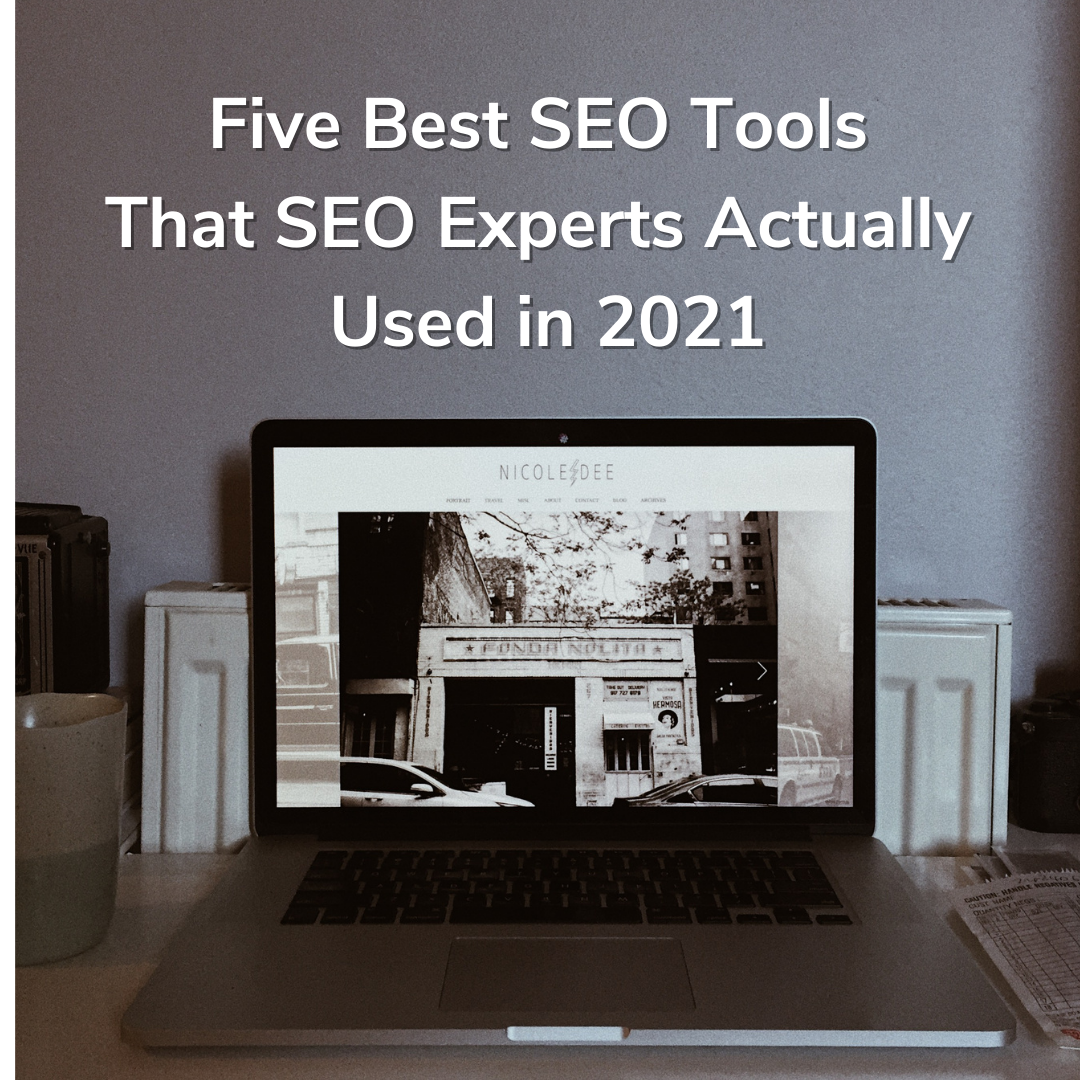Creating and Delivering Offers that Work!
Welcome – Thank you for joining me – My name is Danna Crawford and I’m also known as Power Selling Mom – quick info about me … I’m an authorized local expert with Constant Contact. I’ve been using their service since 2006 and shortly before that I became a Certified business consultant, trained by eBay after being an active seller on the site since 1997 – With my experience of teaching eBay classes and workshops in partnership with the United States Postal Service, Constant Contact contacted me to go through their certification program and now I do webinars and local workshops on the topic of social media and email marketing.
Next I became the Development Director for our local Foodbank after a meeting with the board while I was teaching them about fundraising using Constant Contact and eBay, next thing you know they offered me a part time job that I couldn’t resist since I’m passionate about the Cause of feeding America – So those are the three hats I wear, Constant Contact, eBay and the Food bank! You can learn more about me by visiting my website at PowerSellingMom.com or just google my name “Danna Crawford”. NOW, enough about me, lets talk about YOU and how you can become a marketer!
Let me take just a minute to explain what Constant Contact is for those who may not be familiar.
Constant Contact is a do-it-yourself online marketing system. You can use it to be a marketer for your own small business or organization. The company is best known for its email marketing tools. It’s easy to create and send mass email, like newsletters or announcements and updates.
You can run special promotions or offers; you can build online surveys and polls to gather feedback; and you can promote and manage your events using Constant Contact with registration tools, payment acceptance and invitations – all in one place.
NOTE: All of this information is provided to me by Constant Contact as an Authorized local expert I’m happy to share these transcripts with you.
You can use all the tools and tips we’ll discuss today in your own small business or nonprofit marketing. You can be a marketer. All it takes is Constant Contact.
Before we jump into the content of today’s webinar, I want to give you a simple definition, or a framework, for what marketing really is.
You already know, generally, what it is – but when I say the word marketing, I mean something very specific and it’s important that we are on the same page. My definition of marketing has three parts:
- First, you define an audience: a group of people that you want to target.
- Second, you reach out to them with a message that is specific to that audience.
- And third, you elicit a physical and measurable response – which are the results that you want (and need) your business to get.
What kind of results are we talking about?
These are examples of physical and measurable responses. These actions represent a decision by a person to do something in response to what you put out there. It’s not a mechanical response, it is human. And it must be measurable.
But keep in mind that your overall goals come back to why you’re in business or what’s going to keep you in business……generating revenue or donations. If the responses you’re getting don’t lead in some way directly to the bottom line, then you should evaluate why you’re seeking those types of responses.
Offering promotions – and soliciting for donations – are all ways to keep your organization in business, because, when they’re planned well, they will increase revenue. They are great ways to reward and engage current customers, clients and members – to bring in repeat business – and to attract new clientele.
A great place to start with generating revenue and donations is with email marketing. When it comes to offers and promotions, email marketing is hard to beat. A huge majority of U.S. adults prefer to receive promotional emails from companies they do business with. And about 7 out of 10 U.S. adults have made purchases influenced by a company’s email. When it comes to communicating your offer, it is a very influential medium.
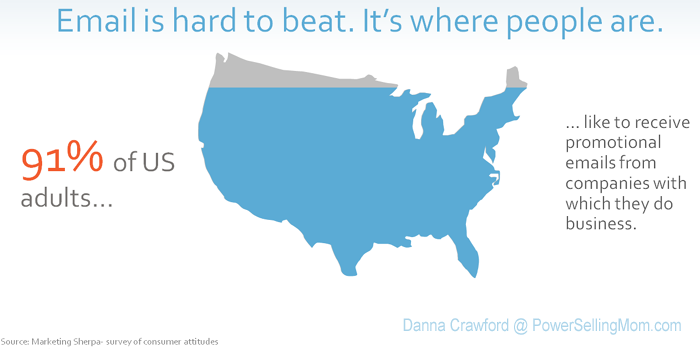
91% U.S. adults like to receive promotional emails from companies with which they do business. That means that your loyal, frequent customers want to hear about your promotions. Source: Marketing Sherpa- survey of consumer attitudes Source: Convince and Convert
Today, we will be walking through the steps for an effective promotion, or offer, for your small business or nonprofit.
- We’re going to start by talking about identifying your marketing goals and creating a strategy for your offer or promotion.
- Next, we’ll talk about how you can determine the best type of offer to help you reach your marketing goal.
- Then, we’ll go over the practical steps for setting up and delivering a campaign, including email marketing and social media.
- And we’ll end by talking about the next steps you can take after your promotion.
Now, let’s start off by identifying the plan for your promotion – first, by identifying your marketing goal, and then understanding how you’ll design your offer to achieve your goal.
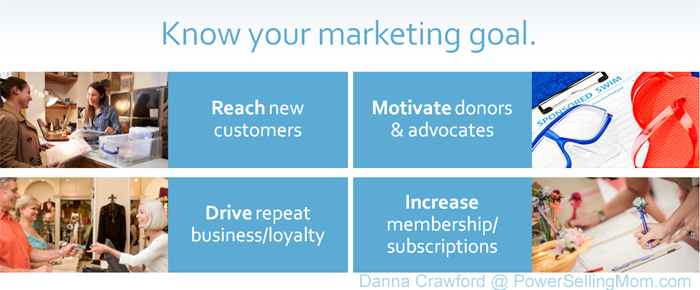
When identifying your marketing goal, you want to keep it to one objective – the one thing you want to accomplish – otherwise, you can cause confusion for yourself and your audience. It might be:
- Reaching new customers or clients
- Driving repeat business from current customers/increasing customer loyalty
- Motivating donors and advocates to take that next step by giving or spreading word of mouth about your cause
- Or increasing your membership or subscriber numbers.
Once you know your marketing goal, you can focus your marketing efforts on achieving it.
And when you’re thinking about what to offer during your promotion, you shouldn’t just be thinking only about what’s good for you and your business. You need to think about what your customers and supporters want!
As a small business or nonprofit, you have an advantage over larger organizations, in that you can have a more direct and ongoing conversation with your customers. These conversations can help guide you in planning your offer, because you’ll know the types of promotions that your audience will respond to.
Your offers and promotions should let your customers know that you value their business. That means giving them a deal on items or services that they already want. Don’t make your promotion about clearing out unwanted merchandise or promoting underused services. Instead, offer things that are already in-demand.
If you’re a nonprofit, you want to use events like special offers or promotions to nurture your relationships with donors and supporters, and show that you appreciate their contributions. You can do this by offering discounted membership, or incentives for giving, such as being listed as a sponsor for a program or event.
And regardless of whether you’re a for- or nonprofit organization, the promotions you offer should be desirable and help you attract new customers or supporters. Create a buzz to help you grow your organization!
Because email is such a powerful way to communicate, it’s a great place to start with your promotion. And when you’re sending out an email promotion, you have a lot of different options. You should consider sending separate emails specifically about your promotions, but also make sure you’re mentioning them in any regular email newsletters you send, as well as all of your social networks, on your website, and in your physical location if you have one – anywhere you interact with your customers and clients.
What kinds of promotions are best to include in your emails?
- You can send a coupon or offer a discount
- Free shipping – This is an example from Bisque Imports, a business that sells ceramics and wholesale art supplies offering free shipping on orders of $100 or more. Their email goes the extra mile with some helpful tutorials on using some new products.
- Suggest products or services, as Bisque Imports does.
- Encourage customers to buy directly from your website – Door County Coffee celebrated the launch of its new website by offering email subscribers a code to get 25% off if they bought online.
- If you’re a nonprofit and are running a donation drive, make your email readers aware
- You can also offer other promotions that increase awareness of your nonprofit organization, by hosting events and asking people to register or become sponsors.
- And you can use email to increase membership for a nonprofit or if you’re a retail organization and have a loyalty program, you can build it through email.
When you’re sending an email, you need to grab people’s attention! Just like you, your audience is busy, and when they open any email, they are subconsciously asking themselves: Why should I care about this? So when you create an email campaign about your promotions, make sure you’re answering that question. You need to tell them what’s in it for them and get their attention.
- Think about your subject line. Use a strong subject line that tells them the most important information in this email. More than 1/3 of people open an email based on the subject line alone. Keep the deal prominent.
You should also make it clear to your readers what your offer is. When they know there’s something in this email that benefits them, that answers the question, “Why should I care?”, then they’ll be more likely to act on your offer. Make sure the top content of your email also answers this question.
One really important thing to take into account is your timing – we’ll talk more about this later, but you want to give people enough advance time to know about your offer (but not too much that they might forget about it!) and even a reminder just before or during the offer to keep it top of mind. Make sure you appeal to your audience’s fear of missing out J
Now, a lot of the words we use in promotions, like “free” and “now” can actually trigger email spam filters. Other things that set off the spam alarm are the use of all capital letters and excessive punctuation or special characters. If you need a guide on what NOT to do, take a peak into the junk or spam folder of your own email account! There is a balance to this – you may in fact be offering a free item, or a buy-one-get-one-free offer, so make sure your subject line doesn’t have words in all capital letters or excessive punctuation. Be specific about your offer with a strong subject line. You can check before you send – if you’re using Constant Contact, it has a built in spam checker. It will tell you if there’s a chance you might be seen as spam and suggests ways to fix any potential issues it identifies. Source: 35% of all recipients of email choose whether or not to open a message on the subject line alone. – inwise “The Magic Words: The Importance of the Subject and ‘From’ Lines for Email Marketing” (2012) 51% of emails are now opened on mobile (Litmus, January 2014)
And always make sure you’re sharing your promotions everywhere your audience is, including on social media
- Share your email on your social media profiles
- Post updates about your offers everywhere you can
- Share product photos, and include details about the deal in the caption, as Taza Chocolate does in this example from Facebook.
- Ask for donations if you’re a nonprofit. The Rescued Pets Movement, a nonprofit that uses both email and social media to get the word out about its cause, uses the “donate” tab on Facebook, so their supporters can contribute without leaving the social network where they spend a ton of time.
- You can also use social media to take the pulse of your audience – ask questions to spark conversation. Which of your products or programs do they like best? What do they want to see more of? These kinds of conversations can help you plan future promotions and keep your offers relevant.
Now, some advice about your limitations – the “fine print” of your offer.
You are the expert on your business. When you’re considering the type of promotion or offer you are going to do, make sure you are prepared to deliver. If you only have one staff member, and your offer requires people to call in, you may need to get volunteers or even hire temps to help answer phones, which could chip into your bottom line – and you also need to make sure you have the technology to handle an influx of calls!
Make sure you have the inventory available to fulfill orders, and that your promotion is ultimately a benefit to you – you don’t want to offer such a deep discount that it negatively affects your bottom line. Not every discount has to be 50% off in order to drive sales. But make sure you’re offering things that your customers want, and you’re not just trying to clear out products that haven’t sold in the past.
You should also structure the deal so that you can continue with your normal business and increase revenue. If your regular clients can’t make appointments with you because all of your resources are tied up in the promotion, it could have a negative effect.
For nonprofits, make sure you have the staffing/volunteers to handle donation drives and plan special events with the goal of making money (for example, don’t host a black-tie dinner at a fancy hotel if you don’t think you’ll raise enough to cover costs and benefit the organization). With events, consider asking for in-kind donations, such as donated event space, catering or equipment, to help offset the costs.
You should also carefully plan out your restrictions, by explicitly stating conditions like the expiration date of your offer, or a limit of purchases per customer. If you leave loopholes, such as “25% off through Sunday,” without specifying WHICH Sunday, you could end up locked into a promotion you could only afford to run for a finite time.
You should ALWAYS check your communications for clarity and typos before you send anything out, but it’s especially important to your organization when you’re thinking about offers and promotions. Before you send out any email offer or promotion on social media, send it to yourself or a person you trust to go over the fine print and make sure it’s clear, not open to any different interpretations! And make sure all of your links work. You don’t want to send someone to an error page on your website when they’re trying to give you money!
I know this sounds like a daunting thing to consider, but there is a positive side to making sure you’re working within your own limitations. This is also a way you can give a sense of exclusivity to your offer, by giving your audience a sense of urgency – for example, say there are “Only 200 sale items in stock,” or “Just 50 tickets left,” or “5 more days to donate and receive a free gift,” and your audience will know they need to act right away.
Now that you have a marketing goal, and an idea of your promotion, it’s time to decide what form your offer will take.
Once you decide the goal of your offer, you have to determine the kind of offer you will make. These are some ideas that you can use, depending on the goal you set. We’ll go through each type of offer in detail.
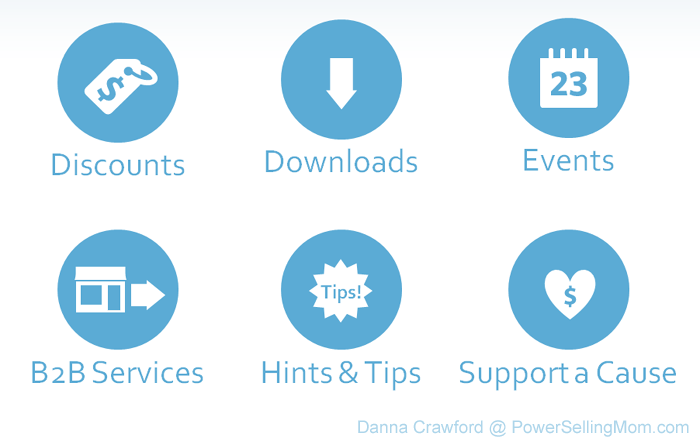
- B2B Services – If your business is a B2B – business to business – and you sell to other businesses, consider offering your expertise. If you’re a marketer, that might be an offer of a free service, like a review of your client’s email newsletters, when they purchase a consultation at full price. You could offer a regular discount on services. Or bundle an offer – provide something extra for a lower rate.
- Events -With events, consider offering an early-bird registration discount, buy-one-get-one tickets, or limited time offers for upgrades, like special seating, parking or admission.
- Downloads -Downloadable content gives your audience some inside tips or information – you can use your expertise to provide a benefit for your customers. These can include tips, a study or guide related to your business or cause, an e-book, advice on what to do or not do while using a product or service, or any exclusive content you may have.
- Discounts -With discounts you can provide a percentage or dollar off through a limited time period, a buy-one-get-one-free promotion, or a gift with purchase. You can also offer coupons – Constant Contact allows users to create a trackable coupon that will tell you who redeemed your offer – making it easier to market to that specific audience in the future.
- Hints and Tips – Educational information is a great offer for customers – people love how-to information and insider tips. Consider giving them tips or steps to solve a problem. Give them insights on the latest trends in your industry. Or provide your expertise or best practices for how to use or maintain your products or services.
- Support A Cause – Nonprofits rely on support from donors and volunteers throughout the year – and if you’re a nonprofit, you can use email marketing to help plan events and donation drives! You could give away exclusive access to an event in exchange for volunteer hours or donations. Or you can offer a sponsorship listing for donors who give a certain amount of money. You can also think about using limited time offers – for example, if your revenue relies on membership, you can offer a “Join today and receive a discount” deal!
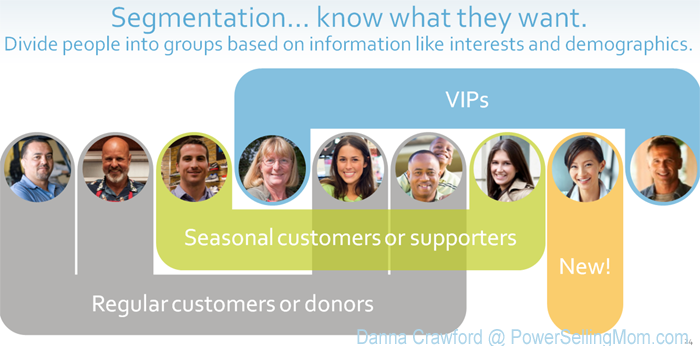
You should choose your offer based on what is most likely to get a response from your particular audience. When you ask your audience what they want (through surveys, social media or just chatting with them in person) and take a look at their behavior, you can find out what promotions they will respond to and you can target your offer to the audience that will act on it. When done correctly, promotions can be very effective. In fact, 76% of email subscribers have made purchases from an email marketing campaign.
If you haven’t heard of segmentation, it’s a marketing term, and it means dividing people into groups based on information like interests and demographics. You might already be segmenting by categorizing or grouping your contacts. It’s important because some promotions are not one-size-fits-all!
Knowing what your audience wants will help you to create relevant promotions– so you’re not wasting your time sending messages they’re not interested in. And if they’re not interested in what you’re sending, they might unsubscribe. Every group of people includes a variety of interests and demographics, so your audience is likely to be divided as well – you might have regular customers or donors, while others are more seasonal; and your new customers or donors are not the same audience as your VIPs, such as vendors, partners, board members and investors. 76% stat source: SmallBusiness.chron.com.
According to a Constant Contact and Chadwick Martin Bailey study, 56% of people who unsubscribed from a business or nonprofit list did so because the content was not relevant. Source: Social Quick Starter.
Now that we’ve looked at marketing goals and types of promotions, let’s talk about campaigns – how you will deliver your promotion or offer.
A campaign doesn’t have to be expensive, or elaborate. Simple is great. To run a campaign, you push content out, like an offer, a free download, a promotion, or fundraising drive, and then you pull a response. A physical, measurable response. You get your audience to react. And a campaign can be sent by email and shared on social media.
Let’s talk about how to make a promotional campaign work.
Timing is important during promotions. When you are planning a promotion, make sure you are reminding your audience with enough advance notice about your promotion.
- Keep key dates in mind, especially if you’re planning a promotion or event around a holiday or other special date, such as this promotion from Spoilt Rotten Beads.
- Also make sure you’re clear on shipping deadlines, if you’re offering something that needs to be ordered. Let people know when they need to purchase in order to get their product on a certain date, and also whether there are any express shipping rates.
Plan for exclusive offers and sales – give your customers enough time to take advantage of discounts and your great deals!
Your promotion should make it easy for customers to answer your call to action. The content you include should help them understand the offer and take action.
This email from Taza Chocolate definitely does that, with a prominent headline that announces a 15% off deal and a discount code. It also helps customers find featured products, with enticing photos of items they have for sale.
You should use images, and communicate through them. An email service provider like Constant Contact makes it easy to turn a picture into a clickable link, so if someone clicks on one of the chocolate products in the email, they’ll be taken right to Taza’s website, where they can buy the product.
And use your design wisely – the template used by No Rest for Bridget is perfect for a retail promotion. It’s well-organized, clean, and has room for a description and buttons that are linked to the products’ pages on the store’s website.
Side note – try to avoid giving too many choices in your campaign. No Rest for Bridget sells other things besides wrap dresses, but they chose to highlight this one item in order to direct attention to a certain product. These are supposed to be quick decisions to act upon. Too many choices will actually reduce the number of actions a person will take. It’s a time limit thing. Think of your campaign as window shopping. You want to entice someone to come in right then and buy because of whatever got their attention in the first place.
Video is a powerful way to engage with your audience. People prefer watching a video to reading long web pages full of text. You can make video work for your business and your promotions.
- The response to video is undeniable. Video content increases click-through rates by 300%. Make sure you mention the video in your subject line for readers to know about it right away.
- What should you feature in your video? For promotions, think about the call to action. If your promotion is about a product, you could consider a customer testimonial or a product demonstration. If you have a new service, show that service in action, as PrimeVet Animal Hospital did with this video. If you are hosting an event, consider featuring a video from a previous event.
- And don’t forget to promote your video. Whatever visual content you use in your email, you can repurpose on your social media. Share your videos on social media to reach even more people, and encourage audience engagement. PrimeVet Animal Hospital shared its doggy daycare video, with a caption describing its promotion, on Facebook. It was liked by 6 people and shared twice.
Source: Forrester study: video content increases click-through rates by 300%.
Ratings and reviews are another way for you to engage your audience, and they can tie nicely into promotions and offers.
- 88% of online shoppers use online reviews to help them to decide on purchases
- Don’t be afraid to ask for feedback! Encourage your audience to write reviews for you – ask them to do it, and include links to relevant places on your website to create those reviews
- Then, include reviews in your content – quote those reviews, link to them in your emails, post them on social media – and keep on top of what your most popular items and services are. These can help you plan future promotions, because your audience is telling you what works, and what doesn’t. If you do get a negative review, make sure you respond professionally, and, if possible, ask the reviewer to contact you offline so you can try to resolve the situation.
Example: Bottlewise: accessories for wine lovers.
(Source: BrightLocal “Local Consumer Review Survey 2014”) Source: Channel Adviser.
Encourage your audience to share your promotions by using social media tools.
- If you are using Constant Contact, add the Share Bar to the top of your emails – allows your readers to post a link to your email on their social media profiles
- Use Simple Share – you can create posts for multiple social media profiles in the Simple Share editor and publish to all of them at once.
- Use social media buttons to give your email audience an easy way to follow you on social media. Remind your audience to share your promotions – ask them to Like them on Facebook, retweet on Twitter or pin on Pinterest. Your audience has a lot of influence via word of mouth, and you can get your promotions in front of more people – their friends and family – if they help spread the word for you.
And don’t forget to make it mobile. More than half of all emails are opened on mobile devices, and so you need to consider mobile design when you send out your email. What this means for you is that your messages should be short and easy to read, and your call to action very clear. This is especially important for promotions and offers – if people have to scroll down, or can’t find the action you want them to take, they’ll ignore or delete your message, or worse – they’ll unsubscribe.
Here are some tips about designing for mobile.
First, avoid using too much text. Think about it – do you want to read long and complex messages on your phone? When you’re on the go? No. Which means neither do your customers or supporters. Do you want to read a message like the one here? Probably not…
What you want is to see something more like this…the result of some basic considerations as you build your message:
- Start to re-think your content. Could it be condensed? Can a picture tell the story better? Can you turn one newsletter into a series by cutting it into pieces?
- If you have longer, or more complex content you want to share, send an email with a clear call-to-action that directs people to where that information lives (on your website or blog).
Tip #2: avoid using multiple columns
Prior to the rise of mobile and mobile communication, emails had started to take on an almost website-like feel – with multiple columns and navigation elements similar to what you find on websites. But with mobile communications driving content to be more focused, and also just to fit a more physically condensed space, multiple columns cause problems.
In this example, you can see how the mobile email client has tried to figure out what to do with the multiple columns…and it has squished them together in a less than optimal way. Using multiple columns can also result in some mobile email clients forcing the columns together into one single column, but that could render the email almost unreadable.
Tip #3: clear and easy calls to action
You want to make it easy for your readers to take an action, to do something that keeps them connected to you – buy a product, register for your event, sign up for services or donate to your nonprofit. You can increase the odds of them taking that action by carefully thinking through the design of your emails.
Notice how the call to action is a button that is clearly separated from the rest of the content, both visually and spatially? This will make it easier for the reader to click on it. You should also consider making your images clickable links …they’re ready-made buttons waiting to be clicked!
A note here on buttons versus text links. What you really want to do is make it easy for your readers to take the action you suggest. Whether you give them large text links (with clear separation from surrounding text) or easy to tap buttons, make sure that there is no confusion about what action you want your reader to take: learn more? Register for an event? Make a donation? Make it incredibly easy…
You should also be thinking about where that button or link takes them – will they be dumped into a screen that is hard to see on a mobile device? That could derail the entire experience for them… So make sure you’re sending them to a website that is also mobile-friendly.
Tip #4: avoid using tiny fonts and hard to read colors
This one would seem to be pretty self-explanatory…but is no less important.
- here’s an example with 9-point font. Yes, a lot of text fits on the screen, but who can read it? People will need to pinch-to-zoom the text, and then have to scroll around. They’re more likely to delete the message, as well as unsubscribe from future small-fonted emails. Some other problems with this example are the color choices – dark backgrounds make it difficult or impossible to read the text, and too many different fonts make the message look sloppy and cluttered.
- this one is a bit better, as the font starts to reach a minimum size that we’d recommend (11 points for body text and 22 points for headlines), and starts to bring greater contrast between the text and the background. But it’s still hard to read, because those sizes are the minimum. The colors are definitely better – a light background with a dark text is the best way to go!
Tip #5: use images carefully
Images are a great way to convey a message, tell a story…create a connection. But if you don’t carefully consider how you’re going to use images, you may end up with some unintended consequences that lead, at best, to someone not reading your email. At worst they’ll unsubscribe from your list and you won’t be able to communicate with them at all. Here are some common challenges to consider:
- notice the red “X” on the screen? That’s there because some mobile email clients may not display images by default…so be sure that you’re using what is called “Alt Text,” or text that appears if the image doesn’t, to at least let people know what’s there.
- in this example, there’s a great picture – a photo of a yoga class – and when viewed on a desktop email client it may look great…but the problem is that on a mobile device, in order to see it, or the rest of the message, the reader will have to pinch and zoom out of the message. This large image has pushed the call to action all the way to the bottom of the message, making it less likely that the reader will actually click through.
- Be aware of where or how an image may appear. You may need to resize images as you build your email (a lot of email marketing tools have simple, built in image-editing capabilities).
Before you send any message out to your customers or supporters, TEST THE EMAIL BY SENDING IT TO YOURSELF!! And then view it with your readers in mind…and make changes accordingly. A few extra minutes of testing can save you from a lot of headaches later!
Now, let’s talk about the next steps you can take to schedule and follow through on your promotion.
Any time you set out to create a special offer or promotion, there are three things you should know. Let’s review them now:
- Know your goal – choose one objective for your promotion – too many will cause confusion for your customers and yourself
- What’s the offer? You have a lot you could choose from – coupons, discounts, gift with purchase, etc. – make it a clear and compelling offer for your customers.
- And know when to send – In order for your promotion or offer to get the best response and success, you need to understand the time and day that your audience is the most likely to take action on your messages. Let’s talk about that now.
Here is a guide to help you determine when your email audience best responds to your email. It can help you in all areas of your email marketing, but when it comes to offers, it can really help you focus in on the time and day of the week when your audience is most likely to open and react to your message.
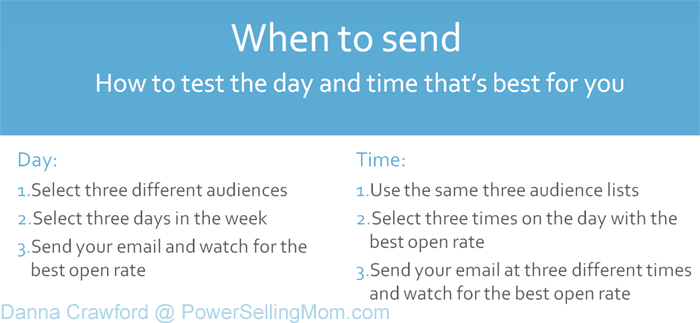
First, find the best day for you to send your email. For this exercise, let’s say you have 300 total contacts. Split your audience into three equal groups – in this case, each group would have 100 people. You will use the same exact email message for the first part of the test.
- Then, select three days in the week. For example, you could test it on Monday, Wednesday or Friday.
- Then, send your email to the first group of 100 on Monday, the second on Wednesday, and the third on Friday. After that, you can use your email marketing to analyze your results. Study your open rates for each day, and also which dates people answered your call to action (clicked on your link, registered for your event, donated, etc.) – that information will tell you what the best day is for you to send.
- The next time you send an email, find the best time of day to send, using the same three audience lists.
- Using the best day from the first part of the test, select three times of the day that you want to test sending your email.
- Send your email to the first 100 people in the morning, the next 100 at lunch time, and the final 100 in the late afternoon or early evening. Again, analyze your results and remember to measure the actions people take in your email. Using this method will give you the best day of the week and the best time of the day to send your email!
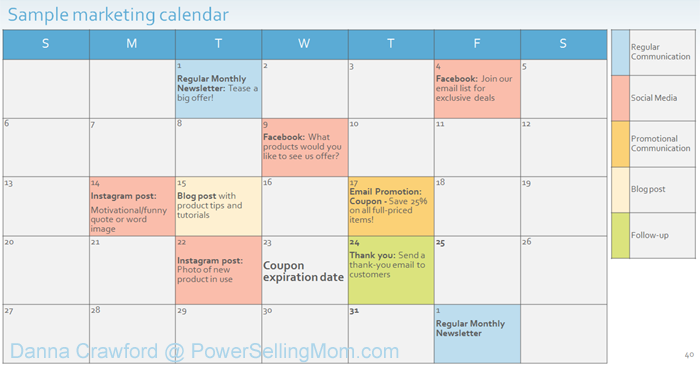
Once you’ve identified the best time and day for your particular audience, you can begin to schedule your promotion. If you’re new to promotions, don’t feel like you have to do EVERYTHING on the screen. This is a pretty advanced plan, and it’s just an example, to give an idea of the types of things you can schedule during a promotion.
Keeping a calendar is a helpful way to stay organized during a promotion, or really any kind of marketing plan. You can use whatever works best for you, whether that’s a calendar on your smartphone or tablet, a Google doc, Outlook, a planner, or just a bunch of Post-It notes. Knowing when you’ll communicate with your audience and planning ahead is a big time-saver. To make it even easier on you, you can automate things…
We know you’re busy, and you might not want to be – or can’t be – on your computer all day. Save yourself some time by using some automation tools that do the work for you.
- Start simple by setting up welcome or update messages for your email marketing. They can be triggered to send to your list when someone signs up.
- Create your emails in advance and schedule them to send at the times and dates that you choose.
- You can also try autoresponders – these are emails that are sent out based on certain triggers, like holidays, birthdays or anniversaries.
- You can also schedule your social media posts – you don’t have to be sitting in front of your computer to post to your networks. Facebook has its own scheduling tool, but the other networks don’t.
- You can use tools like Hootsuite to schedule posts for Facebook, Twitter and LinkedIn. Hootsuite also has an Instagram feature that reminds you when to post content, and makes it easy to share your images.
It doesn’t take a lot of time to keep on track with social media. Try at least 20 uninterrupted minutes at a time, 3 to 5 times a week to make social media planning, posting and monitoring part of your regular schedule.
Once your promotion or offer is over, you’re not done. In fact, analyzing how you did is one of the most important parts.
If you’re not measuring, you are not marketing. Period.
You should know who is opening your marketing emails, when and how many times – what they clicked on – individually and generally. Know how many people respond to your surveys, sign up for your events, pay for your events or pay for a special deal, or make a donation if you’re a nonprofit.
Here is one of the reports in Constant Contact. Most reputable email services will give you similar reports
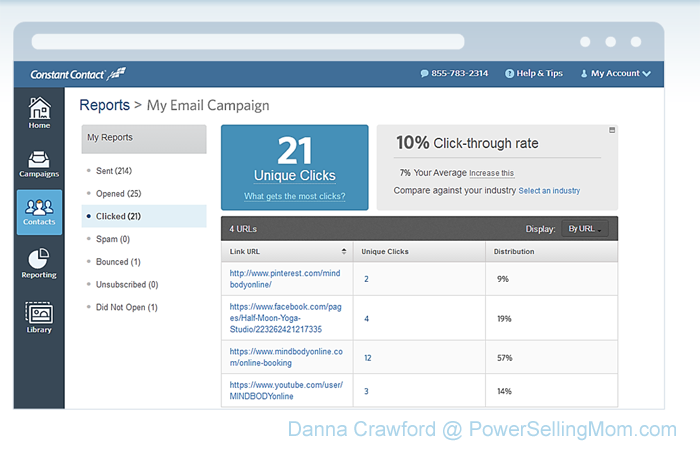
You have to know what is working and what isn’t – because you should do more of what is working and stop doing what isn’t. You have to measure in order to know what will help you grow.
In addition to measuring and analyzing your results to help you understand what worked, there are a few ways you can follow through on your promotion to complete a great experience for your customers.
- First, say “THANK YOU!” to show that you appreciate their support. It’s a personal touch that goes a long way – you can ask them to review their experience with you, send them a token of appreciation, such as a small discount or gift for donating, or simply say thanks.
- Send them your newsletter (after asking for their permission, of course!) You can incentivize and reward your loyal customers who sign up for your newsletter with email-exclusive deals in the future.
- Add the people who acted on your offer to a special list which you can use to send targeted offers. You can do this in an email marketing system by using the reporting tools to find out who clicked on your offer or redeemed a trackable coupon.
- Lastly – encourage the people who responded to your offer to join you on your social networks like Facebook and Twitter. No matter the email service provider you use, it’s important to stay in touch with customers after the promotion as a way to cultivate those new relationships, an easy way to do that is to have them share their experience on social networks.
Continuing to engage with your customers through email and social media will keep you informed about what they want from you, and will keep them loyal, repeat customers.
If you want to learn more about this or other marketing subjects, you can visit my “Email Marketing” section or “Social Media Marketing” to learn more. Sign up for a free trial of Constant Contact, and access tons of helpful marketing resources within the platform.
Here is a copy of the WEBINAR REPLAY BELOW:
NOTE: Please know if you prefer some “hands-on” assistance, I am here for you. Visit the social media package options. I can walk you through or manage it for you. CLICK TO LEARN MORE.
Meanwhile, hope to see you on a future webinar. Subscribe to the list at: JoinMyNewsletter.com

